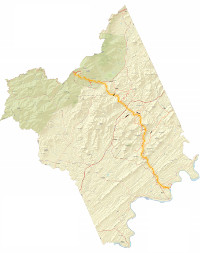by Mary Eiserman | Jun 30, 2025 | Community Conversations, Energy
We are grateful to all who participated in our first Community Conversation held at the RVCC lounge on Wednesday, June 25, 2025. This was a follow-up discussion to our Impacts of Energy Forum at the Nelson Center on April 30.
Fourteen people attended, including some of the experts from organizations represented at the Forum: Gary Wood of CVEC, Elizabeth Putfark and Kat King of SELC, and Jason Leffler of Truline Solar.
Much of the conversation focused on data centers, including the rapid expansion in size and number of data centers due to Generative Artificial Intelligence. The point was made that although our internet browsing habits matter, large AI platforms and bitcoin mining are by-and-large driving this expansion, and the large electricity need that comes with it. We discussed kinds of energy loads, what legislation is being discussed, and who are the major players, including regulatory bodies like the State Corporation Commission and representatives who we can contact at all levels – Board of Supervisors, and state and national legislators. It is difficult because our grid is just not set up for this kind of transition. Lots of options were talked about from data centers shaving their operations during peak times to battery storage to data centers making their own electricity using gas powered generators which some are already doing until we can meet the demand.
Several articles and resources were shared during the event and on email:
– Weathering Climate Disasters with Resilience Hubs – RMI
– Rethinking Load Growth: Assessing the Potential of Large Flexible Loads in US Power Systems
– Not all AI prompts are equal. Some emit 50x more carbon
– Google buys Botetourt County land for data center plans – Cardinal News
– Why Google’s data center project in Botetourt gets applause while others don’t and how the planning for it began long before the web even existed – Cardinal News
There was also good discussion on the role of residential solar power, electric vehicles and battery storage potential, as well as anticipated increase in power source diversification and need for grid readiness.
by Mary Eiserman | Jun 28, 2025 | Energy
AI prompts are a mysterious energy drain, and demand for data centers is high, with more proposed every day.
Follow a columnist from the Wall Street Journal as they attempt to trace an AI prompt and its energy use. How much energy does your AI prompt use? I went to a data center to find out.
Some types of AI are less energy intensive than others. An Anthropocene magazine article shares how some prompts emit 50x more carbon than others.
by Mary Eiserman | Jun 20, 2025 | Clean Energy, Energy
For power to flow from source of generation to user, an activity known as balancing the grid occurs. Any imbalance between the power produced and the energy being consumed at millions of endpoints can cause an imbalance in the system. Grid operators can either allow the imbalance to overwhelm the system – which can cause extensive damage to the electromechanical parts of the system – or they can start to force customers off the grid with rolling blackouts. If the grid goes out of balance faster than grid operators can react, the safety equipment on the grid takes over, shutting off major swaths of the network and causing massive blackouts that can take days, weeks or longer to recover from.
To balance supply and demand, utilities have traditionally relied on central power stations, and when demand peaks, they have turned to so-called peaker plants that often run on fossil gas. But renewable energy and batteries offer cleaner ways to balance the grid. Complicated? Yes!
Learn more from the below linked article;
The power grid explained — plus demand response virtual power plants and more,… | Canary Media
by Mary Eiserman | Jun 18, 2025 | Energy
Resources for the Future (RFF) is an independent, nonprofit research institution in Washington, DC. The mission of RFF – a 501(c)(3) – is to improve environmental, energy, and natural resource decisions through impartial economic research and policy engagement with 5 core values:
Improving both environmental and economic outcomes.
Adhering to the highest scientific and professional standards.
Preserving nonpartisanship, integrity, and trust.
Building a diverse, equitable, and inclusive community.
Leading to better public- and private-sector decisions.
The article linked below highlights trends that are likely to occur through 2050
Global Energy Outlook 2025: Headwinds and Tailwinds in the Energy Transition
by Mary Eiserman | Jun 4, 2025 | Energy
This article highlights trends that are likely to occur through 2050. The organization presenting the information is Resources for the Future (RFF), an independent, nonprofit research institution in Washington, DC. The mission of RFF – a 501(c)(3) – is to improve environmental, energy, and natural resource decisions through impartial economic research and policy engagement with 5 core values:
Improving both environmental and economic outcomes.
Adhering to the highest scientific and professional standards.
Preserving nonpartisanship, integrity, and trust.
Building a diverse, equitable, and inclusive community.
Leading to better public- and private-sector decisions.
Global Energy Outlook 2025: Headwinds and Tailwinds in the Energy Transition from Resources for the Future
by Mary Eiserman | May 31, 2025 | Clean Energy, Energy
Although solar and wind farms require less land than some rival non-fossil-fuel power sources (such as biomass burning), they require MORE land than fossil fuels. Using agricultural or forested land has become a problem throughout the world. This article reviews ways to reduce the impact of solar farms through building solar farms on old industrial, brownfield sites, and decommissioned landfills; installing floating solar panels on existing lakes behind dams; growing forage crops such as alfalfa and hay in the gaps between solar panels; grazing sheep in rows between solar panels; incorporating crops that require afternoon shade; and forbidding solar farms on top of peat deposits, prime ag land, and replacing forest with panels. Building floating wind farms in deeper waters can avoid much of the killing that occurs when birds fly into the structures, particularly at night.
‘Green Grab’: Solar and Wind Boom Sparks Conflicts on Land Use – Yale e360






